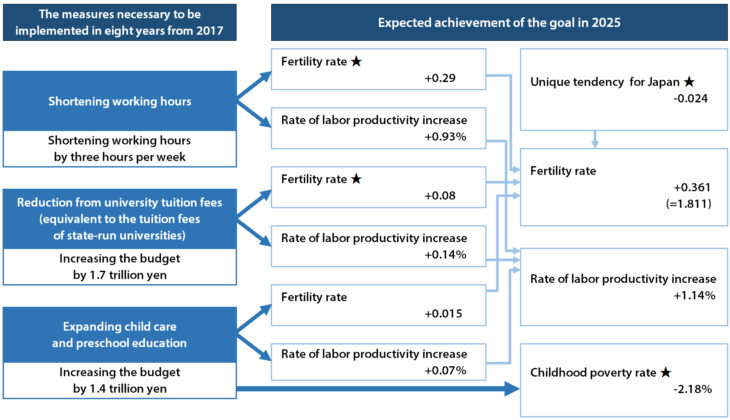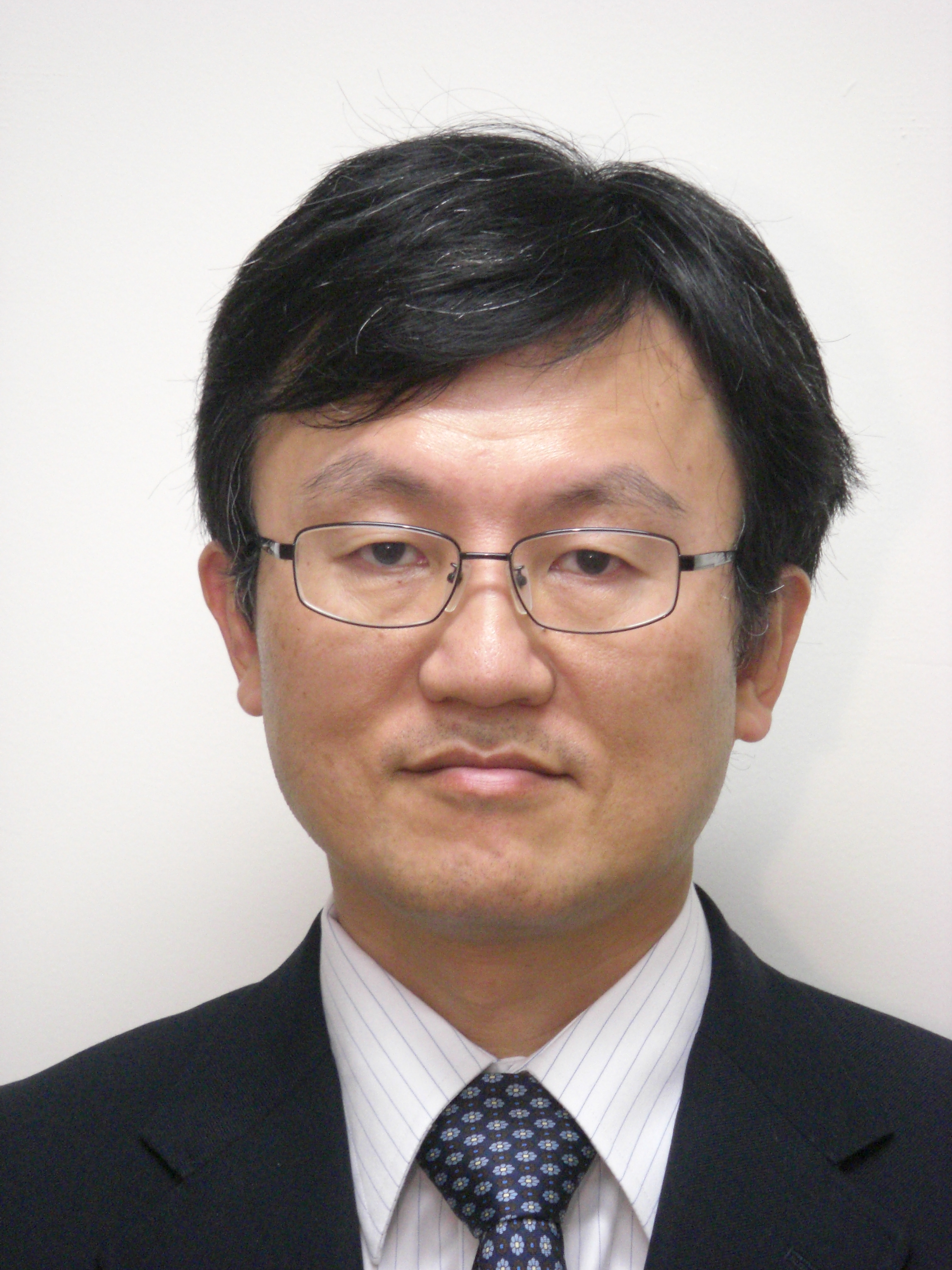A New Perspective on Measures for the Declining Birthrate: Expected fertility rate of 1.8 can be realized Put all necessary measures into action in eight years
< Key Points >
- Shortening working hours and reducing university tuition fees are effective.
- Initiatives to eliminate waiting lists for nursery school enrollment and provide free preschool education should also be pursued.
- Improvements in labor productivity and childhood poverty rates could also be at-tained.

Shibata Haruka, Associate Professor, Kyoto University
If increasing the fertility rate and birthrate are set as policy goals, a society might be created in which people that do not have children feel pressured. The policy goal of taking measures to address the declining birthrate should be to create an environment in which people who want to give birth to children can do so.
The government has set the goal of realizing the expected fertility rate of 1.8 by 2025. This numerical target is based on an estimate of the number of children desired by the child-rearing generations gauged from nationwide surveys in 2010. Because the fertility rate was 1.45 in 2015, the goal is to increase that rate by 0.35 by 2025.
* * *
According to many surveys, the following four measures can be expected to be effective as measures for addressing the declining birthrate.
First, marital fertility rates barely decreased after the 1980s, but marriage rates decreased. A primary factor in the decrease in the fertility rate is the decrease in the marriage rate.
What sort of person has a greater tendency to get married and have children? According to the Special Report on the Longitudinal Survey of Adults in the 21st Century (2013) published by the Ministry of Health, Labour and Welfare, both men and women with higher incomes are able to get married more easily and couples with dual-incomes and wives who can utilize child-care leave systems are able to give birth to a first child. That is, those with a more stable income are more likely get married and have children.
Therefore, (1) increasing child-care allowances and (2) reducing university tuition fees will lead to significantly reducing child care and education costs, which is expected to be an effective way to address the declining birthrate and support marriage and childbirth.
According to the result of the Longitudinal Survey of Adults in the 21st Century (2002–2015), couples in which the husband does more housework and child-care hours on weekdays and holidays are able to have two children or more. Because it is conceivable that husbands who have to work longer hours tend to have fewer housework and child-care hours, (3) shortening the amount of working hours can also be expected to be an effective measure for the declining birthrate.
In addition, according to the Special Report on the Longitudinal Survey of Newborns in the 21st Century (2013) published by the Ministry of Health, Labour and Welfare, dual-income couples that used child care services when their first child was below the age of three could have a second child more easily. According to an analysis conducted by a research team led by Associate Professor Unayama Takashi at Hitotsubashi University, data collected around the 2000s show that prefectures with increased quotas for authorized nurseries relative to young female populations tended to have increased fertility rates. This means that (4) expanding child-care and preschool education can also be expected to be effective measures to address the declining birthrate.
These four measures to address the declining birthrate can also be expected to be beneficial from an economic perspective.
According to an analysis by Associate Professor Unayama, (1) increasing child-care allowances is expected to increase consumption in lower income households with smaller assets in terms of economic effects.
(2) Reducing university tuition fees is expected to contribute to government finance by 1.3-fold of investments (including per-student 510,000 yen equivalent to the tuition fees of state-run universities in four years) from a long-term perspective as well as to raise educational standards. (Refer to trial calculations by the National Institute for Educational Policy Research.) From a short-term perspective, the reduction of university tuition fees will cause some of the savings of the child-rearing generations to be allocated toward consumption, which will increase the demand for consumption, resulting in greater added values for products and services as well as higher labor productivity.
For (3) shortening working hours, according to an analysis by a research team led by Professor Yamamoto Isamu at Keio University, data collected from about 800 domestic companies from the 1990s to the 2000s show that companies with higher degrees of labor protection and higher rates of full-time employees and those that are active in female promotion showed a greater tendency in the increase of total factor productivity (the ratio of added values to the total amount of invested capital and invested labor) in a few subsequent years through efforts to decrease the long working hours.
(4) Expanding child care and preschool education can be expected to produce economic effects by increasing the female employment rate. According to an analysis by a research team led by Asai Yukiko, a JSPS Postdoctoral Fellow at the University of Tokyo, data collected about the 2000s showed that prefectures with an increase in quotas for authorized nurseries relative to the population below the age of six showed a greater tendency toward increasing the employment rates of mothers. In addition, according to an analysis by a research team led by Associate Professor Unayama, data collected about the period from the 1980s to the 2000s also showed that prefectures with an increase in the quotas for authorized nurseries relative to young female populations showed a greater tendency toward an increase in employment rate for young women.
In addition, according to an analysis by Professor Yamamoto, data for about 1,000 listed companies during the 2000s showed that companies with an increase in the proportion of women in permanent employment showed a greater tendency for increased profitability rates. This tendency was more apparent in companies with better work-life balance systems (short-hour employment systems and the establishment of dedicated departments for work-life balance systems). This suggests that female participation in the labor market tends to increase workplace productivity.
In the meantime, according to a survey by a research team led by Professor Anme Tokie at the University of Tsukuba, parents with children below the age of three are more likely not to slap their children if they use authorized nurseries, which leads to boosting the development of the children’s social abilities. In addition, according to an analysis by Professor James Heckman at the University of Chicago, the development of social abilities will create larger contributions to government finance than the invested amounts from a long-term perspective. The expansion of child care services will also enable parents with lower income rates to have dual incomes, which will lead to a reduction in childhood poverty rates.
To what extent will these four needed measures be implemented to increase the fertility rate by 0.35 by 2025? How much will labor productivity and childhood poverty be improved by such efforts? From this perspective there were no existing trial calculations.
A roadmap for achieving an expected fertility rate of 1.8

Note: The author’s trial calculations. ★ means five-year analyses (fixed effects model, etc.) and the others mean one-year analyses (first-difference generalized method of moments [GMM]). When conducting analyses, the author also took into account changes in social and economic conditions other than policies.
Therefore, the author analyzed the effects of these four measures using data for about twenty-eight Organisation for Economic Co-operation and Development (OECD) member states including Japan from 1980 to 2009 and conducted trial calculations on those effects by applying the analytical results to Japan. (Refer to the figure shown above.) Because the author only applied the past average tendencies of the above-mentioned OECD member states to the future of Japan and the mechanisms of causality are also unclear, the analyses and trial calculations are merely rough estimates. The author sincerely hopes that his analyses and trial calculations will spark debates with a new perspective for the possibilities of policy effects.
For (2) reducing university tuition fees and (3) shortening working hours, an analysis of the one-year data changes detected no effects on fertility rates, but an analysis of five-year data changes detected effects. In conducting the latter analysis, because the author had to adopt a simple analytical method due to the small number of data points for time, he could hardly remove the reverse causality. Therefore, readers should note that policy effects may be overestimated to a considerable degree.
Except for these factors, the author mainly conducted one-year analyses and discussed the details in Child-Rearing Support Can Save Japan (2016). Regarding (1) increasing child care allowances, no effects were detected on fertility rates and labor productivity, but it showed slightly smaller improvement effects on childhood poverty rates than the expansion of child care services do.
The author’s trial calculations are based on realizing the following measures in eight years, from 2017 to 2025: (2) reduction from university tuition fees equivalent to the tuition fees of state-run universities (510,000 yen) for all students (projected 5 percent increase in the percentage of students who go on to tertiary education and an increase of 1.7 trillion yen in the annual budget); (3) shortening annual working hours by 150 hours (a weekly average of three hours) (equal to 1.5-fold of a shortened margin of 102 hours from 2000 to 2015) and (4) realizing no children on the waiting list for nursery school enrollment (a projected amount of 300,000 as of the end of 2017) by expanding child care and preschool education (an increase of 1.4 trillion yen in annual budget).
The implementation of all of these measures is expected to increase the fertility rate to 1.811 by 0.361 by 2025, realizing the expected fertility rate of 1.8. Compared with the non-implementation of these measures, their implementation is expected to increase the rate of labor productivity increase (annual average of 0.93 percent for the period from 2010 to 2015) by 1.14 percent on the annual average and reduce the childhood poverty rate (16.3 percent in 2012) by 2.18 percent by 2025.
Financial resources of about three trillion yen are necessary to realize these measures, but the author argued in his above-mentioned book based on his trial calculations that those funds can be raised by expanding the inheritance tax, imposing income restrictions on tax deductions for spouses and introducing progressive tax impositions on pensions. These measures for creating financial resources will also be effective for increasing consumption, promoting employment and realizing more efficient finances.
Because the author’s analyses and trial calculations are still rough estimates, the author sincerely hopes that government-affiliated research institutes will conduct more accurate analyses and calculations.
Translated by The Japan Journal, Ltd. The article first appeared, before revision, in the “Keizai kyoshitsu” column of The Nikkei newspaper on 8 February 2017 under the title, “Shoshika taisaku ni aratana shiten (2): Kibo-shusshoritsu 1.8 wa jitsugen kano (New perspective is being required for the countermeasures to the falling birthrate (2): “The desirable birthrate of 1.8” is realizable).” The Nikkei, 8 February 2017, p. 28. (Courtesy of the author)




